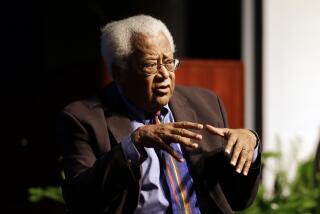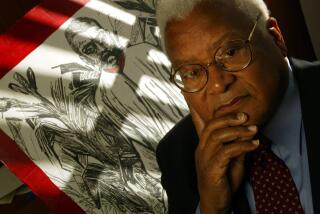What Were They Thinking as They Died in Jonestown? : SALVATION AND SUICIDE An Interpretation of Jim Jones, the Peoples Temple, and Jonestown<i> by David Chidester (Indiana University Press: $18.95; 190 pp.) </i>
On Nov. 18, 1978, at a jungle commune in Guyana called Jonestown, 914 men, women and children died in a mass murder-suicide. Their leader was the Rev. Jim Jones, who had moved most of his Peoples Temple members from California the year before. The deaths occurred shortly after Jones ordered the ambush of a congressman and news reporters about to leave Guyana with 14 dissatisfied members. News of the act stunned the world for weeks.
Using David Chidesterâs empathetic interpretation of the religious world view of Peoples Temple, it could be described thus:
At the âultimate day of salvation from time itself,â within what had become a new sacred center to replace the polluted places of persecution in California, 914 people, who had striven to establish a loving, egalitarian socialism, committed revolutionary suicide. The decision to die, ordered by a God-man who embodied Divine Socialism, involved ritual (one practiced before), release (from the torture by outside invaders Jones said was imminent) and revenge (on enemies who Jones said would âpay for thisâ). The event repelled the world, which distanced itself from what it deemed a crazed demagogue and his brainwashed zombies.
That summary does not do justice to the authorâs full analysis, which draws on research in the history of religions, anthropology and other academic disciplines. But it indicates his motives for the study.
Chidester, a lecturer in religious studies at the University of Cape Town, says that previous efforts to understand the Jonestown event âconsistently discounted the possibility that the Peoples Temple had been a genuine religious movement sustained by an authentic religious worldview.â The reactions of outsiders ânullified the humanity of the people who claimed to have constructed meaningful, legitimate, fully human identities within the Templeâs religious worldview.â
By Chidesterâs count, more than 20 books and innumerable journalistic accounts have decried the moral evil of Jones and his movement. Refusing to moralize himself, Chidester said he employed a method to âdemonstrate how such an âevilâ could look good within its own consistent, coherent internal context.â Despite affiliation with the mainline Christian Church (Disciples of Christ), based in Indianapolis where Jones first established his church, Jones taught a theology that had eerie affinities to ancient Gnosticism. Chidester noted that Jones resembled an otherworldly redeemer in Gnostic myth. Jones said he was miraculously conceived when his mother made mental contact with another planet. He was born on earth to save others and tell them that they were caught in the despicable web of capitalism.
Very much like the radical revision of Judaism by Sethian Gnostics in the first, second and third centuries AD, Jones presented the true God as a metaphysical entity, which he variously called Principle, Love or Divine Socialism. This God, of which Jones was the manifestation, was higher than the evil Creator, who unjustly demanded obedience. Jones, in typically coarse language, retold the Creation stories in ways to get his audience to laugh at the biblical myths. However, Gnosticism, which was lambasted by early church leaders, was never reported to have conducted a mass murder-suicide.
Chidester makes a plausible case for the movementâs religious framework and for its human appeal for followers willing to overlook Jonesâ staged healings, foul language, and extraordinary demands on their time and privacy. For his mostly black following, Jones declared himself to be black and assigned a positive meaning to the word nigger. He crusaded--often with the admiration of politicians and religionists in the 1970s--for the dignity of minorities, the poor and the old.
While not claiming a definitive explanation for the mass murder-suicide, Chidester noted that Jones had vowed repeatedly that defections--a growing number in the 1970s--or removal of members from the commune would be met with violence and their own corporate suicide. On the afternoon of Nov. 18, 1978, Rep. Leo Ryan, a defector and three newsmen were killed and others injured in gunfire at the Port Kaituma airstrip. Chidester said the organic unity of Jonestown had been âseverely disruptedâ and the only means for ârestoring the purityâ were âacts of redemptive violence.â Then, probably the majority of the commune âembraced death as a way of sealing their witness,â Chidester wrote.
Chidesterâs primary sources were 900 FBI-stored tape recordings of sermons and rallies led by Jones at his Redwood Valley, San Francisco and Los Angeles churches and at his self-imposed Jonestown exile precipitated by an August, 1977, magazine expose.
In covering religious movements for The Times, I can attest to the value of hearing or reading what spiritual leaders say to their own flock (as opposed to what they say for public consumption). But I think Chidester misleads his readers when he questions the reliability of the âatrocity storiesâ told by Peoples Temple defectors of beatings and enforced poverty of members while saying the news media discounted âthe testimonies of current members.â
Defectors frequently exaggerate, but their information can sometimes be confirmed or corroborated through other sources. Peoples Temple members, not untypical for members of tightly knit movements, were either shielded from the press or were expected to present a public relations face to reporters.
Chidester seems to downplay the significance of Jonesâ manipulative techniques, and I suspect not just because it was outside his bookâs outline.
In May, 1976, Jones organized in Los Angeles a joint Black Muslim-Peoples Temple rally for interracial harmony which several Christian leaders attended. The event was unprecedented. Most of Jonesâ teachings and practice were unknown, but his energy for social equality was praised, despite his reportedly eccentric manner.
Everyone entering the meeting place had to pass through metal detectors, but when I was permitted a brief interview with Jones in back of the stage, several bodyguards and aides formed around in a tight circle--backs to us and faces peering for potential assassins.
Itâs an old story for authoritarian religious movements: Cry persecution, do things that invite criticism or demand investigation, and, behold, a self-fulfilling prophecy. Maybe it is moralizing, but there are some religious groups and some humans that are just bad. Jones was one.
More to Read
Sign up for Essential California
The most important California stories and recommendations in your inbox every morning.
You may occasionally receive promotional content from the Los Angeles Times.









